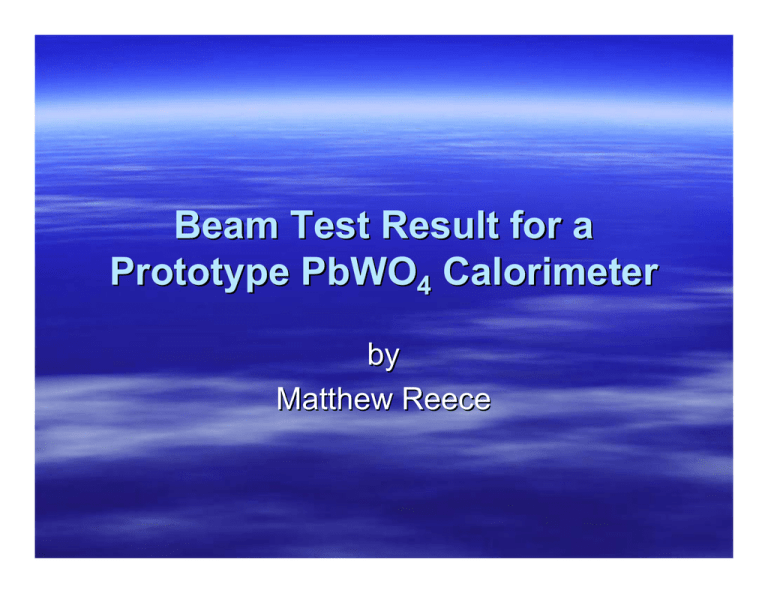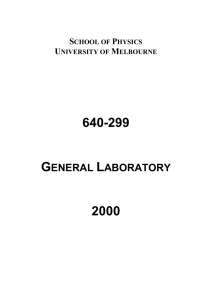Beam Test Result for a Prototype PbWO Calorimeter by
advertisement

Beam Test Result for a Prototype PbWO4 Calorimeter by Matthew Reece PrimEx experiment The goal of the PrimEx collaboration is to determine the lifetime of the π0 particle with greater accuracy than ever before. This is done by measuring the small-angle coherent photoproduction of π0 in the Coulomb field of a nucleus, known as the Primakoff effect. PrimEx experiment The π0 decay proceeds primarily through the chiral anomaly and represents one of the most definitive tests of low-energy quantum chromodynamics. This measurement of the π0 lifetime will have an error of less than 1.5%, which is on par with the theoretical uncertainty. The improved precision is partly enabled by the development of a hybrid detector consisting of a multichannel lead glass detector with a high resolution PbWO4 center. Description of prototype calorimeter 6x6 array of lead tungstate crystals of size 2.05cm x 2.05cm x 18cm inside a thermostatically controlled and optically isolated box. Since PbWO4 light yield depends strongly on the temperature of the crystal (a change of about 1% per 2 K), the temperature was held at 278 K with a fluctuation of less than 1 K. Description of prototype calorimeter The 18 crystals for the top half of the detector were made in Russia, while the 18 for the bottom half were made in China. The crystals were arranged this way so that the performance of the Russian and Chinese crystals could be checked independently. Each crystal is divided into fibers such that the distance between two adjacent crystal fibers is 2 mm. Description of beam test In the prototype beam test, the photons from Jlab’s photon beam were converted into electrons by the target. The electrons were bent by a sweeping dipole magnet toward the detector. The detector was moved in X and Y so that the electrons passing through the center of the X-Y coordinator could roughly hit the center of the concerned crystal for a given test run. Description of run selection It was necessary to choose a run which was aimed at one of the center four crystals in order to have a meaningful 5x5 plot. Only runs 413 and 419 meet this criterion. I chose to analyze experimental run 413 because more events occurred in this run than in run 419, the other experimental run inside the center four. Beam location in X and Y Calibration constants In order to perform the analysis of the beam test, the results must be properly calibrated. The total energy of the particles is given by E= n ∑E i =1 i where E is the total energy of the particles, Ei is the energy deposited in the ith crystal, and n is the total number of channels. Calibration constants The primary goal of the calibration is to determine the values of αi. In the simplest method, we define some other Ei: Qi E i = E e− ⋅ αi where Ee- is the incident electron energy, αi is the calibration constant, and Qi is the ADC pulse height for the ith crystal. Calibration constants Now the minimization of the function n 2 ( E − E ) ∑ j e− j =1 yields a simple expression for the calibration constants αi: n n E Qk m+1 m m k αi = αi ⋅ ∑ = αi ⋅ ∑ m k =1 Ee− k =1 α k Calibration constants Now we define some weights Wi for smooth 2 iteration: ⎞ ⎛ ⎜ Ei ⎜ Wi = n ⎜ ⎜ ∑ Ek ⎝ k =1 ⎟ ⎟ ⎟ ⎟ ⎠ This weight is the square of the fraction of energy deposited in the ith channel over total measured energy. Calibration constants After 5 iterations or so, the value of αi reaches a plateau and varies less than 1%. Using this weight, the iteration now becomes α im +1 = α im ⎡ ⎤ ⎢ ⎛ n Q ⎞ Wi ⎥ k ⎜ ⎢ ⎥ ⋅ 1 + ⎜ ∑ m − 1 ⎟⎟ ⋅ m ⎢ ⎝ k =1 α k ⎠ W i ⎥⎥ ∑ ⎢⎣ i =1 ⎦ It should be noted that αi does not depend on the angle or position of the particles that are hitting the detector (otherwise these calculations would be much more complicated). Calibration constants The analysis program PAW++ gives more accurate results if the inverses of the calibration constants are used. Therefore, the energy is better defined as n n i =1 i =1 E = ∑ Ei = ∑ where βi =(αi)-1. Qi βi Energy calculations I then conducted the analysis of the beam test. I used plots of sizes 1x1, 3x3, 5x5, and 6x6 (the entire prototype detector) at the central fiber location (X fiber 30,Y fiber 31). Here are the results: Energy results Energy results Energy results Energy results Energy results Energy analysis The energy with respect to X fiber number is given by E = 3.5004 + 1.5153 ⋅ 10 −2 ⋅ x + 4.6112 ⋅ 10 −5 ⋅ x 2 + 1.1645 ⋅ 10 −7 ⋅ x 3 , so that the electron energy at X=30 is 4 GeV. This is the energy used for the % error, not the reconstructed energy. Energy results Plot Size Reconstructed energy (GeV) σ (GeV) 1x1 3.217 3x3 0.1200 % of 6x6 energy 75.25 σ/E (% error) 3.00 4.010 0.0759 93.8 1.89 5x5 4.215 0.0675 98.6 1.69 6x6 4.275 0.0643 100 1.61 Resolution analysis I then performed resolution analysis on the 6x6 plots. Only the change in σ with respect to x position needs to be considered, as the sweeping dipole only works in this direction. The change in σ with respect to Y position is only a statistical effect. Resolution analysis I then looked at plots for every X fiber value at Y fiber 31. All X fibers outside of the range from 28 to 50 turned out to be junk data. In addition, there was a bad data point inside this range at X=43. Resolution result Conclusion PbWO4 is a good material for this sort of detector, with the mean resolution of energy being 1.51±0.056%. The actual result should be lower because I was unable to subtract energy spread and noise to a sufficient level. References “A Precision Measurement of the Neutral Pion Lifetime via the Primakoff Effect”, TJNAF PAC 15 proposal, 1998. B. Hu, “The analysis of primex test run on September 15”, Primex papers, 2002. A. Gasparian, “Energy calibration and gain monitoring system for lead glass shower counters of the HMS and SOS spectrometers”, 1992. A. Gasparian, “Performance of PbWO4 crystal detectors for a high resolution hybrid electromagnetic calorimeter at Jefferson Lab”, 2002.


